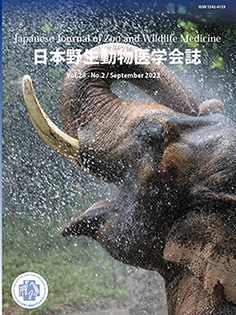Volume 28, Issue 2
Displaying 1-10 of 10 articles from this issue
- |<
- <
- 1
- >
- >|
Full paper
-
Article type: Full paper
2023Volume 28Issue 2 Pages 65-72
Published: September 01, 2023
Released on J-STAGE: November 01, 2023
Download PDF (648K) -
Article type: Full paper
2023Volume 28Issue 2 Pages 73-80
Published: September 01, 2023
Released on J-STAGE: November 01, 2023
Download PDF (1196K)
Review article
-
Article type: review-article
2023Volume 28Issue 2 Pages 81-89
Published: September 01, 2023
Released on J-STAGE: November 01, 2023
Download PDF (416K)
Research note
-
Article type: Research note
2023Volume 28Issue 2 Pages 91-94
Published: September 01, 2023
Released on J-STAGE: November 01, 2023
Download PDF (797K) -
Article type: Research note
2023Volume 28Issue 2 Pages 95-101
Published: September 01, 2023
Released on J-STAGE: November 01, 2023
Download PDF (452K)
Case report
-
Coprological Investigation of Gastrointestinal Parasites in Wild Birds Protected in Kochi PrefectureArticle type: case-report
2023Volume 28Issue 2 Pages 103-106
Published: September 01, 2023
Released on J-STAGE: November 01, 2023
Download PDF (197K) -
Article type: case-report
2023Volume 28Issue 2 Pages 107-114
Published: September 01, 2023
Released on J-STAGE: November 01, 2023
Download PDF (285K) -
Article type: case-report
2023Volume 28Issue 2 Pages 115-120
Published: September 01, 2023
Released on J-STAGE: November 01, 2023
Download PDF (211K) -
Article type: case-report
2023Volume 28Issue 2 Pages 121-127
Published: September 01, 2023
Released on J-STAGE: November 01, 2023
Download PDF (1175K)
Practical information
-
Article type: Ptactical information
2023Volume 28Issue 2 Pages 129-134
Published: September 01, 2023
Released on J-STAGE: November 01, 2023
Download PDF (254K)
- |<
- <
- 1
- >
- >|
